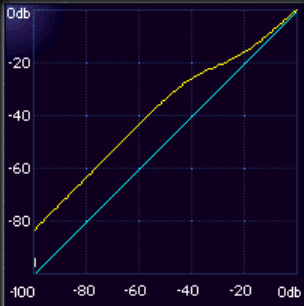
Waves LinMB software guide page 18 of 28
change at all, which means everything well below it gets “lifted up”. (If you
take this just a bit further, you’ll figure that all audio exactly at the Threshold
will have half of the Range’s value in positive gain).
O
NE MORE WAY TO THINK ABOUT IT
Here is another bit of help so that you can really learn and use the power of
the LinMB to its fullest capability. We’ll take another example from the Waves
C1 Parametric Compander, our one-band processor (it also does wideband
and sidechain). It has a typical ratio and makeup gain control and has been
widely used for upward compression (both wideband and split-band
parametric usage).
The Linear MultiBand Parametric Processor has a very similar compressor
law as the Waves C1 and the Waves Renaissance Compressor. This model
allows the “compression line” to return to a 1:1 ratio line as the level continues
to increase. In other words, there is no compression of the low signal,
compression around the Threshold, and once the signal goes quite a bit past
the Threshold, the compression tapers off back to a 1:1 line (no compression).
In the graphic shown, you can see this exact type of line. The ratio is 2:1 and
the Threshold is –40dB. The line is just curving a bit (-3dB down point) at the
–40 input (the scale at the bottom). Output level is the scale on the right
vertical edge, and you can see that at about –20dB, the line starts curving
back to a 1:1 line.
So, very high-level audio peaks between 0 and –10dBFS are not touched at
all, audio between –10 and –40 is compressed, and audio below –40 is not
compressed, but is clearly louder at the output than at the input. This is low-
level compression, or “upward compression”. Such a trick is very useful and
has been implemented by classical recording engineers, mastering houses,
and classical broadcasting. Low-level compression can “lift” soft sounds up
gently and leave all the high-level peaks and transients completely untouched,
reducing the dynamic range from the bottom upwards.
We did say that the LinMB was “very similar” to the C1, but different in a
significant way: the Threshold defines the midpoint of the Range. Therefore,
to achieve the same curve in the LinMB as shown here, the Threshold on the
LinMB would actually be about –25 with a Range setting of +15.5dB. Now this
is a very large amount! The example shown here was merely to make it
obvious; we picked the 2:1 line only because it is easier to see on the page. In
reality, low-level compression that lifts the softer audio up 5dB is equivalent to
an approximate ratio of 1.24:1. Lifting the low-level up about 5dB is a good


















